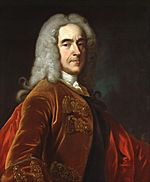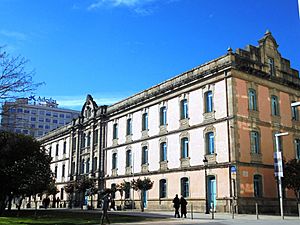Capture of Vigo and Pontevedra facts for kids
Quick facts for kids Capture of Vigo and Pontevedra |
|||||||
|---|---|---|---|---|---|---|---|
| Part of War of the Quadruple Alliance | |||||||
 Present day view of Fort Castro in Vigo which was captured by the British in 1719 |
|||||||
|
|||||||
| Belligerents | |||||||
| Commanders and leaders | |||||||
| Strength | |||||||
| 1 ship of the line 3 frigates 8 bomb vessels and fire-ships 4,000 soldiers |
3 Forts ~1,000 soldiers & militia |
||||||
| Casualties and losses | |||||||
| 300 casualties, sick or dead to disease | Vigo 300 killed or wounded, 468 captured 7 ships captured or burned Pontevedra 200 surrendered |
||||||
The Capture of Vigo and Pontevedra was a military event that happened in October 1719. It was part of the War of the Quadruple Alliance. A British expedition landed on the Spanish coast. They took control of the towns of Vigo, Redondela, and Pontevedra. The British forces stayed for ten days. They destroyed or captured many military supplies. Then they left the area.
Contents
Why the British Attacked Spain
This attack was a response to Spain's actions. Spain had sent troops to Scotland earlier in 1719. Their goal was to help a Scottish uprising against the British government. But the Spanish troops were defeated at the Battle of Glen Shiel.
So, the British decided to strike back at Spain. They wanted to show Spain that they could attack its coastline easily. This attack was also meant to pressure Spain to agree to a peace treaty. The British worked with France, who was also attacking Spain from the east.
The British expedition was led by Lord Cobham. The navy was commanded by Vice Admiral James Mighels. Their fleet included a large 70-gun warship, three smaller warships called frigates, and many transport ships. About 4,000 soldiers were on board. Major-General George Wade commanded these soldiers.
The Expedition Begins
Taking Vigo
On September 21, the British ships left Falmouth, England. They arrived at Vigo, Spain, eight days later. The fleet quickly entered the harbor. Soldiers landed on a beach about three miles from the town.
On October 1, the army took a strong position. It was near the San Sebastián fort. This fort was across from Fort Castro. Fort Castro was on a hill overlooking the town and harbor. That evening, Brigadier Philip Honeywood led 800 soldiers. They surprised the Spanish defenders at San Sebastián. The British disabled the Spanish cannons and the Spanish soldiers retreated to the main fort, called the citadel.
Two days later, a special ship called a bomb ketch was brought closer. It could fire bombs, but it was still too far away. So, forty large mortars (weapons that fire shells high into the air) were brought ashore. On October 3 and 4, several large siege cannons were also brought from the ships. These were added to the artillery at San Sebastián.
On October 10, a heavy bombardment began against the citadel. The Spanish soldiers inside were outnumbered. They knew no help was coming. So, they decided to surrender. The Spanish garrison included soldiers from the Regiment of Spain and the Regiment of Valencia. Their commander was Don Fadrique González de Soto. About 469 officers and men marched out and were captured. Around 300 Spanish soldiers were killed or wounded during the attack. The British lost only six soldiers killed and twenty wounded.
The British found many guns, small weapons, and ammunition. These supplies were captured or destroyed. They also learned from prisoners that these supplies were meant for an invasion of England. Sixty large cannons in the town were made useless. In the citadel, forty-three more cannons were also destroyed. Seven Spanish ships in the harbor were captured. Three of these ships were being prepared to attack other ships as privateers (armed ships owned by private individuals but authorized by the government to attack enemy shipping).
The British troops also found large amounts of wine. Many soldiers drank too much for three days. Lord Cobham ordered the remaining wine to be loaded onto the ships. It would be taken back to England as part of the captured goods.
Moving to Redondela and Pontevedra
On October 10, Lord Cobham sent Major General George Wade with 1,000 soldiers and marines. They sailed on four transport ships to the bay of Pontevedra. Meanwhile, with Vigo now secure, 2,000 British troops stayed there. Lord Cobham also ordered other troops to move further inland.
A small British force reached the town of Redondela. They found it undefended. Its old fort was in ruins. The British burned and looted the stores in Redondela.
Capturing Pontevedra
On October 14, British troops landed at Pontevedra. They quickly overcame any Spanish resistance. They moved through the town from the upper end of the harbor. Fort Marin was the next obstacle. It defended the town. A force of 100 grenadiers, led by John Ligonier, easily captured the fort.
Spanish resistance collapsed. Pontevedra was in British hands by the end of the day. Eighty-six cannons of different sizes were made useless. The arsenal (a place where weapons are stored) was burned. General Wade also demanded money from Santiago de Compostela. He threatened to attack that city if they didn't pay £40,000. The invasion damaged the large Real Maestranza Barracks. At that time, it was used to store old weapons, grenades, bombs, gunpowder, and melted artillery.
The British commanders realized they had achieved their goals. They decided there was no need to hold the area. Enough damage had been done to stop Spain from trying to invade the British Isles again.
After the Attack
On October 24, Lord Cobham loaded his army back onto the ships. Two days later, the fleet sailed for England. On November 11, Vice-Admiral Mighells arrived in Falmouth with most of the ships.
The amount of captured goods was huge. They brought home 190 iron cannons and 30 brass cannons. They also took 10,000 firearms, 2,000 barrels of gunpowder, and other supplies.
This expedition was quick and very successful. It achieved all its objectives. The British lost only about 300 men due to sickness, desertion, or combat.
This attack shocked the Spanish government. They realized how easily Allied forces could attack their coast. This meant a new front could open up far from the French border.
See also
 In Spanish: Toma de Vigo para niños
In Spanish: Toma de Vigo para niños



